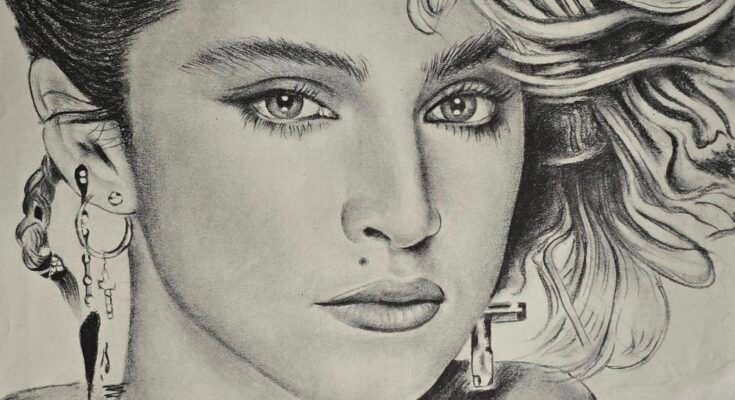There’s a certain kind of nostalgia that creeps up quietly—almost like a soft whisper from the past—when we least expect it. For many of us, this moment can be triggered by something simple: a song on the radio, the smell of an old perfume, or the crinkle of aged paper beneath our fingers. For others, it can be more profound, as was the case when I recently stumbled upon a drawing I had bought years and years ago—long since forgotten, buried in the treasure trove of my Madonna boxes in storage.
This isn’t just a story about a forgotten piece of art. It’s about memory, obsession, cultural history, and the joy of rediscovery.
The Madonna Obsession
Let’s begin with what Madonna represents to a generation—indeed, to multiple generations. For many of us who came of age in the 1980s or 1990s, she wasn’t just a pop star. She was the pop star. A shapeshifter, a provocateur, a feminist icon, a fearless voice in an industry dominated by men. Madonna defined and defied boundaries, challenging our ideas of femininity, sexuality, and performance art.
Over the years, I, like so many others, became an avid collector—not just of her music, but of everything Madonna-adjacent. Vinyl records, glossy magazine covers, limited-edition tour merch, bootleg cassettes from rare performances, and yes, fan art and commissioned pieces that captured her essence in strokes of ink, paint, and charcoal.
Somewhere along the way, I came across a drawing. It was raw, emotional, and oddly vulnerable—far from the polished veneer of her usual portrayals. I bought it from a small art fair in New York, if memory serves, maybe in the early 2000s. It wasn’t expensive, but it spoke to me deeply. Then, as life carried me forward, the drawing was packed away with other Madonna memorabilia, safely tucked into a box marked “Storage – Madge Collection.”
The Joy of Rediscovery
Fast forward to present day. I found myself in a rare mood to organize the storage unit I had long ignored—dusty, cluttered, and echoing with memories. There, buried beneath layers of bubble wrap and yellowing newspapers, I found the box. The writing on the cardboard had faded slightly, but I knew it instantly. I opened it expecting to find the usual suspects: posters from the Blond Ambition Tour, VHS tapes of Truth or Dare, a “Like a Virgin” limited-edition vinyl. And then there it was.
The drawing.
Unframed but kept carefully between two pieces of thick cardboard, the artwork stared back at me as though no time had passed. It was Madonna, but not the Madonna of magazine covers. This was Madonna with tired eyes, smudged eyeliner, a slight slump in her shoulders. The artist had captured something intimate—something unguarded.
And I had forgotten it even existed.
Art and Memory
Rediscovering that drawing wasn’t just a moment of personal surprise—it was a revelation. It made me reflect on how memory works, how we archive parts of our lives, sometimes unintentionally. We keep things, pack them away, and forget about them, only to reencounter them years later as if they were time capsules.
The drawing reminded me of who I was when I bought it. A young, hungry pop culture enthusiast, working my first real job in a city that never stopped buzzing. I was enamored with the idea of celebrity, fascinated by the construction of image and identity. Madonna embodied all of it—and this drawing, with its raw portrayal, was like a small rebellion against her public persona. It was a peek behind the curtain. I loved it then. I love it now, perhaps even more.
Madonna’s Timelessness
Even more striking is how the rediscovery of the drawing coincided with Madonna’s ongoing influence. Even today, she continues to reinvent herself—her music, her fashion, her politics. And while younger generations might know her differently, the core of her impact remains undeniable.
She represents the freedom to change, the courage to be controversial, and the artistry of building a personal mythology. In many ways, this drawing—hidden away for years—is a metaphor for Madonna herself: layered, unexpected, and still capable of stirring deep emotion decades later.
Final Thoughts: The Treasure We Forget We Own
Finding that drawing felt like reclaiming a piece of my past, a piece of Madonna’s narrative, and a reminder that sometimes the most beautiful discoveries come from the forgotten corners of our lives. It made me wonder what else lies tucked away—what artifacts of identity and passion have been temporarily buried under the weight of routine.
So if you’ve got boxes in storage, open them. Flip through old sketchbooks, sift through dusty collections. Somewhere in there might be a spark waiting to reignite your memory—and maybe, just maybe, something you once loved that’s ready to be loved again.
Because sometimes, what we forget tells us just as much as what we remember.



